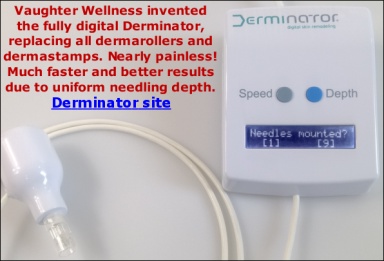63
« on: February 21, 2010, 03:38:03 PM »
> I have a very deep nasolabial furrow;
> I won't consider face lift or filler injection; do you think
> dermarolling can diminish the fold; if so, how likely can it be totally
> gone?
First of all, it is completely natural to have a nasolabial fold. Even children have them when they smile and some have them even when they don't smile.
The nasolabial fold forms the border between the cheek and the lip. It's more or less the price we have to pay for smiling.. If you have never smiled in your life, your nasolabial fold would likely be much shallower but it would not be worth it would it?
As we age, our nasolabial folds get more pronounced. One of the most common reasons is the change in the cheek mass and its support, principally the slow migration of cheek fat down the face. Some small additional causes are the atrophy of dermal collagen and increased skin laxity.
Unfortunately, there is no way how a dermaroller could affect the muscle tone, volume and distribution of subcutaneous fat etc. A dermaroller can only affect the skin itself, not the fat and muscles underneath the skin.
Obviously, if you tighten the facial skin by dermarolling it will likely reduce the nasolabial fold but it doesn't address the main cause – the drop down of fat and other structures under the skin.
The deepening of skin folds/lines is caused by:
-loosening of ligament attachments that attach the skin to the underlying tissues and to the bone
-loss of skin elasticity
-loss of fat
-gravitational forces
A dermaroller can improve only one of them and that is the loss of skin elasticity.
Another improvement you can try to achieve is to increase the collagen and the skin thickness in the fold. That is not going to fix the actual underlying cause of the fold but it might make the fold a bit less prominent (it is certainly not going to disappear though). A lot of new collagen has to be produced so this is a long-term project and you will need patience.
The advantage of the new collagen growth triggered by needling is that such induced collagen is your own and your body is not going to eliminate it. It will stay. Nevertheless you will continue to age of course and gradually lose "volume" in your face.
Injectable fillers do wonders for an immediate effect but that effect lasts until our body metabolizes it and the filler degrades. That can happen as quickly as in 3 months. Long-lasting fillers can cause granuloma formation.
If you desire a long term, very significant improvement of your NL fold, you would have to address the real cause and have a vertical lifting of the fold such as mid-face lift.
> Also, which needle length should I use?
You should stamp the fold with a 1.5 mm dermastamp with 35 needles. Stamp densely every three weeks. Pinpoint bleeding is the limit. Don't go any deeper. You could use a numbing cream. It might be red for several days so do not do both folds at the same time if you don't want to look like a clown.
Alternatively, use aggressively a one line 1.5 mm dermaroller.
On the second or third day, you can camouflage the redness with makeup (or with a sun block with lots of zinc oxide) but don't use any make up immediately after, and one or two days after microneedling. If you have a weekend off then prick on Friday evening and put on makeup on Monday morning.
To tighten the facial skin, use a 1 mm regular dermaroller or longer.





